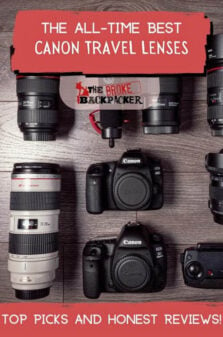Canon is one the most successful and well-regarded lens manufacturers in the world and for good reason – they produce some stunning pieces of glass. Because of this, there is a Canon lens for nearly every type of photography out there – especially for travel photographers!
But sorting through Canon’s lens library can be very daunting. Which is exactly why we wrote this epic guide to the best travel lesnses for Canon.
To shoot like a pro, you have to pack like a pro, and this insider guide to the best Canon travel lenses will show you EXACTLY which travel lens is best for YOU.
So without further ado, let’s get into discussing the best Canon lenses for travel photography (so you can shoot like a pro!)
- Quick Answers: Best Full Frame Canon Travel Lenses
- Quick Answers: Best Travel Lenses for Canon EF-S
- Best Full Frame Canon Lenses for Travel
- Best EF-S Canon Travel Lenses of 2018
- Things to Consider When Buying the Best Travel Lenses for Canon
- FAQ about the Best Canon Travel Lenses
- Final Thoughts
- Buy Us a Coffee!
Quick Answers: Best Full Frame Canon Travel Lenses
- All Around Best Travel Lens for Canon Full Frame – Canon EF 24-105mm f/4.0 L IS USM
- Best Full Frame Budget Travel Lens for Canon – Tamron 28-75 f/2.8 XR Di LD
- Best Full Frame Professional Travel Lens for Canon – Canon 24-70mm f/2.8L II USM
- Best Full Frame Prime Travel Lens for Canon – Canon 50mm f/1.8 STM
- Jump to -> The List of Best Full Frame Canon Lenses for Traveling

Canon EF 24-105mm f/4.0 L IS USM
- Feature Highlights > IS, 77mm filter
- Weight > 1.47 lbs/670 g
- Dimensions > 3.29” x 4.21”
- Price > $489
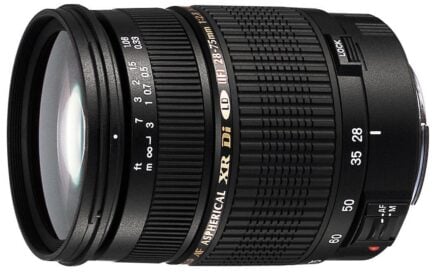
Tamron 28-75 f/2.8 XR Di LD
- Feature Highlights > No IS, 67mm filter
- Weight > 1.12 lbs/508 g
- Dimensions > 2.87” x 3.62”
- Price > $239.99

Canon 24-70mm f/2.8L II USM
- Feature Highlights > No IS, 82mm filter
- Weight > 1.77 lbs/ 805 g
- Dimensions > 3.48” x 4.45”
- Price > $1899
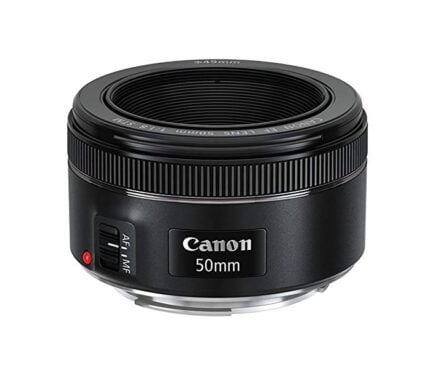
Canon 50mm f/1.8 STM
- Feature Highlights > No IS, 49mm filter
- Weight > 5.64 oz/160 g
- Dimensions > 2.72” x 1.54”
- Price > $109.99
Quick Answers: Best Travel Lenses for Canon EF-S
- All Around Best Travel Lens for Canon EF-S – Canon EF-S 17-55mm f/2.8 IS USM Lens
- Best EF-S Budget Travel Lens for Canon EF-S – Sigma 17-50 f/2.8 EX DC OS HSM
- Best EF-S Professional Travel Lens for Canon EF-S – Sigma Art 18-35mm f/1.8
- Best EF-S Prime Travel Lens for Canon EF-S – Canon 50mm f/1.8 STM
- Jump to -> The List of Best EF-S Canon Travel Lenses of 2018

Canon EF-S 17-55mm f/2.8 IS USM
- Feature Highlights > IS, 77mm filter
- Weight > 1.42 lbs/645 g
- Dimensions > 3.29” x 4.35”
- Price > $879
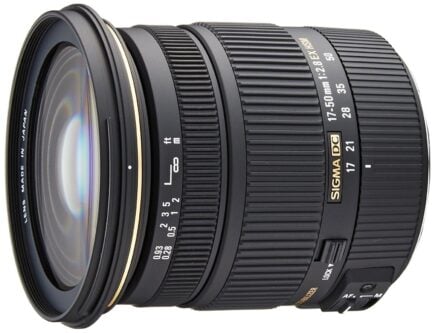
Sigma 17-50 f/2.8 EX DC OS HSM
- Feature Highlights > IS, 77mm filter
- Weight > 1.24 lb/565 g
- Dimensions > 3.3” x 3.6”
- Price > $278
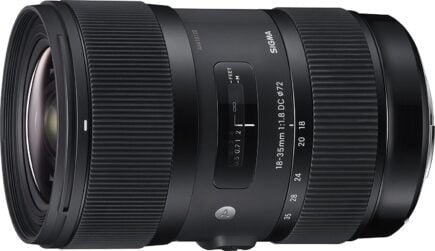
Sigma Art 18-35mm f/1.8
- Feature Highlights > No IS, 72mm filter
- Weight > 1.78 lb/811 g
- Dimensions > 3.07” x 4.76”
- Price > $799

Canon 50mm f/1.8 STM
- Feature Highlights > No IS, 49mm filter
- Weight > 5.64 oz/160 g
- Dimensions > 2.72” x 1.54”
- Price > $109.99
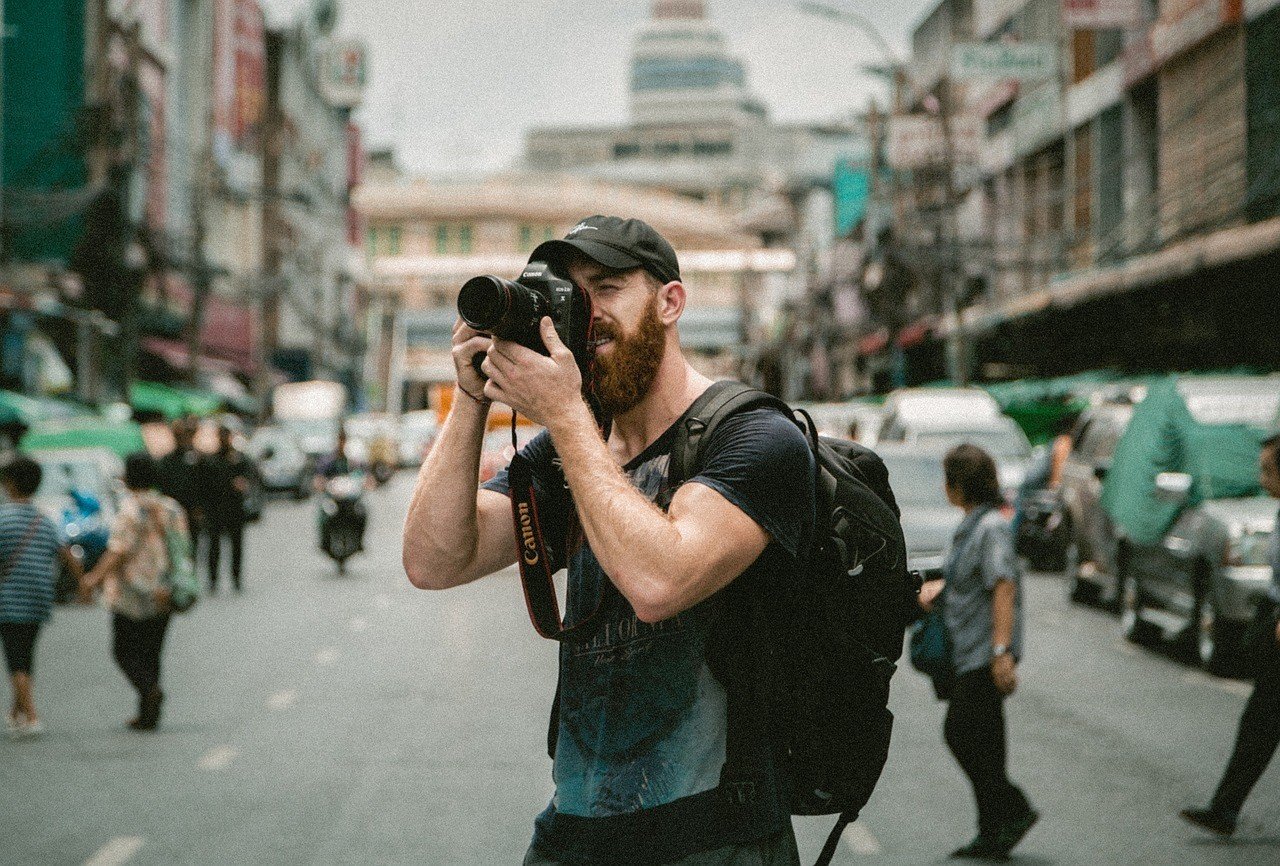
The Broke Backpacker is supported by you. Clicking through our links may earn us a small affiliate commission, and that's what allows us to keep producing free content 🙂 Learn more.
Canon is, in a sense, at the head of the pack when it comes to lens R&D and is usually the vanguard of all things new and exciting in the camera lens world.
If you have a Canon camera (EF or EF-S) and are having trouble finding the best Canon lenses for travel photography, then we’re here to help!
We’ve compiled a list of 16 lenses that are suitable for travel photography. Each has their own merits (and faults) that will suit whatever kind of photographer that you are. Whether or not you’re a professional or an ultralight backpacker or a casual enthusiast there’s a travel lens from Canon out there for you!
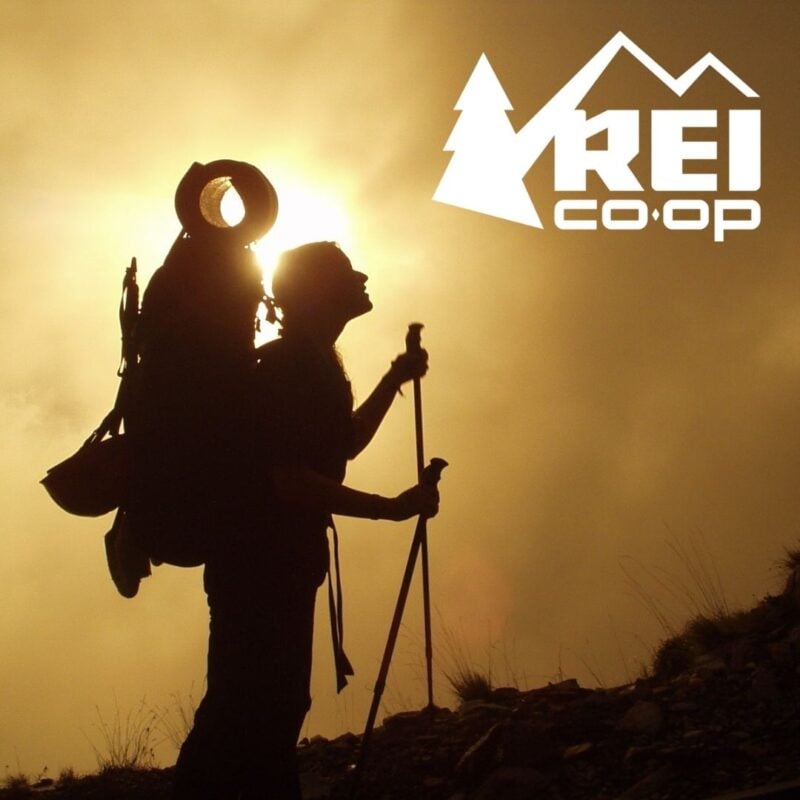
REI is one of America’s biggest and most-loved outdoor gear retailers.
Now, for just $30, get a lifetime membership that entitles you to 10% OFF on most items, access to their trade-in scheme and discount rentals.
Join REI Today!All Around Best Canon Lens for Travel (Full Frame)
Canon EF 24-105mm f/4.0 L IS USM
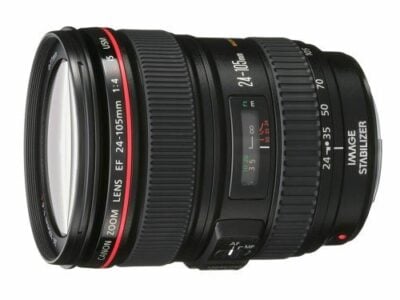
- Weight: 1.47 lbs/670 g
- Dimensions: 3.29” x 4.21”
- Filter Size: 77mm
- Image Stabilization: Yes
- Price: $489
The Canon EF 24-105mm f/4.0 L took the travel photography world by storm when it was released. With solid optics, a very useful focal range, image stabilization, and a respectable aperture, the Canon 24-105mm seemingly has it all. For those who want a useful full frame zoom lens that can do a little bit of everything, the Canon EF 24-105mm f/4.0 L IS USM is a great buy and is our choice for best Canon lens for travel photography.
The Canon EF 24-105mm f/4.0 L IS USM greatest strengths are its focal range and superior optical performance. At 24-105mm, this lens can capture everything from landscapes to close-up portraits.
The f/4.0 aperture, though not the fastest, is still very capable and, when shot wide open, can still create some nice bokeh. The lens is quite sharp – especially when stopped down – and combined with image stabilization and a fast autofocus, images are sure to be crisp.
The of Canon EF 24-105mm f/4.0 L IS USM does suffer from some distortion and chromatic aberrations. These are to be expected though from such a large package and these can easily be fixed in post-processing anyway.
Overall sharpness isn’t jaw-dropping either but, as mentioned before, stopping down the lens can fix this.
- Very useful focal range.
- Solid optical performance.
- Effective IS and autofocus.
- Should be stopped down for optimal sharpness.
- Some distortion and chromatic aberrations.
- Not the fastest aperture.
Best Full Frame Budget Canon Lens for Travel
Tamron 28-75 f/2.8 XR Di LD
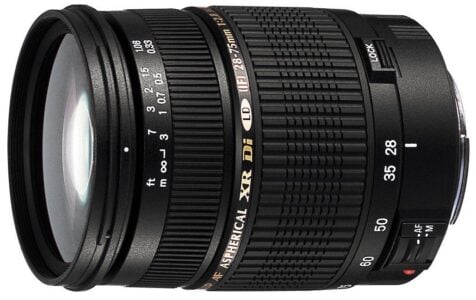
- Weight: 1.12 lbs/508 g
- Dimensions: 2.87” x 3.62”
- Filter Size: 67mm
- Image Stabilization: No
- Price: 239.99
Though we were tempted to name the legendarily affordable Canon 50mm f/1.8 as our pick for best budget Canon lens for travel, we simply couldn’t pass on the Tamron 28-75 f/2.8 XR Di LD.
For around $500, you can get a fast, lightweight, sharp lens; that just about covers all the bases for travel photography! Though it’s not the cheapest lens on this list, the Tamron 28-75 f/2.8 XR Di LD is certainly the best bang for your buck and a great alternative to some of the more expensive full frame lenses.
Aside from the price, the Tamron 28-75 f/2.8 XR Di LD greatest strengths are its size and image quality. At the time of its release, this lens was touted as the lightest and most compact medium zoom lens (that had a f/2.8 aperture) yet. 10 years later, it’s still impressively useful.
With a fixed f/2.8 aperture, the Tamron Tamron 28-75 f/2.8 XR Di LD should deliver excellent image quality as is customary of this type of lens. It doesn, in fact, perform very well, creating pictures that are crisp and sharp. Corner softness is a problem when the aperture is wide open but, like most lenses, this disappears when the lens is stopped down. Distortion is noticeable at wider angles and CA is well controlled throughout.
The Tamron 28-75 f/2.8 XR Di LD is built from high-grade plastics. Usually, in these cases, durability becomes an issue as plastic is less hardy than certain alloys. Given the price point of this lens though (plastic is cheaper) this is understandable and probably forgivable if price is a concern.
- Very affordable.
- Light and small.
- Overall great image quality.
- Soft edges in images.
- No IS.
- Plastic construction.
Best Full Frame Professional Canon Travel Lens
Canon 24-70mm f/2.8L II USM
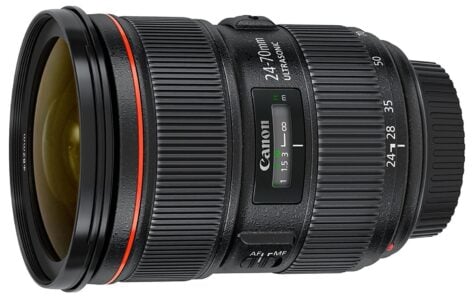
- Weight: 1.77 lbs/ 805 g
- Dimensions: 3.48” x 4.45”
- Filter Size: 82mm
- Image Stabilization: No
- Price: $1899
If you like the idea of having a fast, supremely sharp lens that can outperform all the rest and you don’t have financial concerns, then the Canon 24-70mm f/2.8L II USM is about the best that you can get.
With near-flawless optics, a constant f/2.8 aperture, and superb construction, the Canon 24-70mm f/2.8L II USM is one of the most impressive lenses that you can buy and is our choice for the best professional Canon travel lens.
The Canon 24-70mm f/2.8L II USM is classified as a “medium zoom;” we’d like to call it a “working man’s lens” though because it performs amazingly well and is very reliable. Lenses like these are used by professionals to get shit done. The Canon 24-70mm f/2.8L II USM is no exception.
The Canon 24-70mm f/2.8L II USM’s optics are just about perfect – sharpness is superlative, CA and distortion are extremely well controlled, and mechanics are state-of-the-art. The lens’ autofocus system is silent as the grave and very quick.
The constant f/2.8 aperture performs better when shot wide open than other lenses, so low light photography should be less of a hassle. Throw in a rugged, weather-sealed body that can withstand the elements, and you have a lens that can go anywhere and do (almost) anything.
The Canon 24-70mm f/2.8L II USM is not perfect though. Most noticeably, the lens struggles while shooting subjects up-close – sharpness drops down and focusing becomes finicky at these short distances.
On a more general note, the Canon 24-70mm f/2.8L II USM still lacks image stabilization, which appears to be endemic to all pro-level medium zooms. The price of this lens may make some shudder as well.
- Unbeaten image quality.
- Robust, weather-resistant build.
- Fast aperture and autofocus.
- Very expensive.
- Still no image stabilization?
- Struggles up close.
Best Full Frame Prime Canon Travel Lens
Canon 50mm f/1.8 STM
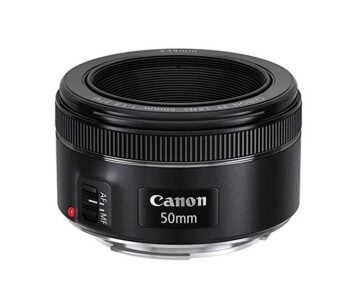
- Weight: 5.64 oz/160 g
- Dimensions: 2.72” x 1.54”
- Filter Size: 49mm
- Image Stabilization: No
- Price: $279.99
Some lenses are just timeless; the Canon 50mm f/1.8 is one of those. For years, the Canon 50mm f/1.8 has been loved and used by thousands of photographers and has solidified itself in their kits. It’s current iteration, the Canon 50mm f/1.8 STM continues the legacy.
There are simply too few lenses that can compete with the Canon 50mm f/1.8 STM’s price point and image quality. This lens is one of the most useful (ever) and travel photographers can grab one for around only $100!
The Canon 50 f/1.8 STM offers great optical quality. When used wide open, the lens has great center sharpness although the edges are somewhat soft.
When stopped down, this softness disappears quickly. CA is well controlled and there is a bit of distortion but latter can be easily fixed in post-processing. Build-wise, the Canon 50mm f/1.8 STM is very-small, near pancake-like, and is built from more durable materials than its predecessors.
One of the reasons the Canon 50mm f/1.8 STM has succeeded so well is its focal length. 50mm lenses, lovingly referred to has “nifty fifties,” are super flexible focal-wise. Nearly any scene can be captured with a 50mm lens, from landscapes to people to urban settings. You can read this article for more on why 50mms are amazing.
Let’s not forget the age-old saying “you get what you pay for” though – the Canon 50 f/1.8 STM, obviously, lacks a lot of things.
Autofocus is reportedly a little sluggish, peak sharpness isn’t achieved until f/5.6, and distortion is apparent, which isn’t something you see very often in prime lenses. Downsides taken into consideration, it’s still hard not to love the Canon 50 f/1.8 STM.
- Price that can’t be beaten.
- Ultra-portable.
- Excellent optics.
- Autofocus can be sluggish.
- Has to be stopped down for best optical quality.
- Some distortion.
Best Full Frame Canon Travel Lens for Landscape Photographers
Canon EF 16-35mm f/4.0L IS USM

- Weight: 1.35 lbs/615 g
- Dimensions: 3.25” x 4.44”
- Filter Size: 77mm
- Image Stabilization: Yes
- Price: $1299
For travel photographers who are going to be taking primarily landscape or, perhaps, interior architecture photos, the Canon EF 16-35mm f/4.0L IS USM is a no-brainer. With astounding optical performance and a relatively lightweight, rugged body, this is the best Canon travel lens for landscape photographers.
Optically, the Canon EF 16-35mm f/4.0L IS USM leaves little to be desired. The lens is amazingly sharp at nearly every aperture until f/16.0 when diffraction sets in. CA is well controlled and distortion, which is very common in wide zooms, is actually well-maintained.
The corners do show vignetting that never really disappears no matter what aperture you’re at but, like distortion, this can be alleviated somewhat in post-processing.
The Canon EF 16-35mm f/4.0L IS USM’s aperture is a little on the slow side and won’t be appropriate for certain situations like astrophotography. Thankfully, this lens does come equipped with image stabilization though, which will be helpful with handheld shooting in low-light as well as videography.
For diehard travel photographers who are constantly on the move, the Canon EF 16-35mm f/4.0L IS USM lightweight will appeal greatly. Given its usefulness, the Canon EF 16-35mm f/4.0L IS USM is quite compact and is thus more versatile.
Thanks to its robust construction as well, this lens will stand up to elements, which landscape photographers will be exposed to quite often.
- Lightweight.
- Excellent optical performance across the spectrum.
- Image stabilization helps with slower aperture.
- Slower aperture.
- Some corner shading.
- Not appropriate for astrophotography.
Best Full Frame Canon Travel Lens for Portrait Photographers
Canon 85mm f/1.8 USM

- Weight: 15 ozs / 425 g
- Dimensions: 2.95” x 2.81”
- Filter Size: 58mm
- Image Stabilization: No
- Price: $499
Much like the Canon 50mm f/1.8 USM, the Canon 85mm f/1.8 USM stuns with its awesome image quality, small size/weight, and, best of all, unbeatable price. For those who enjoy portrait photography, this is the best travel lens for Canon hands down.
85mm is one of the most widely regarded focal lengths among photographers. At this narrower angle, subjects are isolated wonderfully against their backgrounds and bokeh is usually of that dreamy variety. These lenses are also known for being ridiculously sharp.
What dissuades many newcomer photographers from these 85mm lenses are that they are usually prohibitively expensive. Most of the good ones go for at least $1000 or more (the Canon 85mm f/1.2L is $1,800!!!). The Canon 85mm f/1.8 USM, on the other hard, is usually found for only (^) though, which is why it’s such an awesome opportunity!’
The Canon 85mm f/1.8 USM delivers in much the same way as its competitors do – sharpness is excellent, the bokeh is smooth, autofocus is quick, and there is little in the way of blemishes e.g. CA, distortion or vignetting. This lens is the real deal.
The Canon 85mm f/1.8 USM does suffer from some very minor issues – shooting wide open often results in soft, CA laden images plus there’s no lens hood included. In my opinion, these flaws are far-and-away forgivable. At the end of the day, this is a must for any portrait photographer.
- Amazing price given its focal length.
- Stellar optics.
- Very compact.
- Little soft when shot wide open.
- Chromatic aberrations when shot wide open as well.
- No lens hood included.
Best Full Frame Canon Travel Lens for Astrophotographers
Rokinon 20mm f/1.8 AS ED UMC
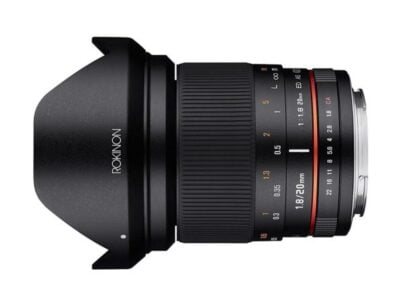
- Weight: 1.09 lbs/497 g
- Dimensions: 3.27” x 3.48”
- Filter Size: 77mm
- Image Stabilization: No
- Price: $599
The Korean company Rokinon, or Samyang as it’s sometimes referred to, is most well-known for producing sharp, effective lenses that are very affordable. The Rokinon 20mm f/1.8 AS ED UMC is one such lens. With this lens, you can capture the night sky in all of its splendor and not have to break the bank in the process. For these reasons, we think that the Rokinon 20mm f/1.8 AS ED UMC is the best Canon travel lens for astrophotography.
Rokinon lenses are cheaper because they lack a lot of the electronics that are found in modern day lenses. Autofocus and some recorded data are possible because of these electronic components and so Rokinon lenses cannot do either. When using the Rokinon 20mm f/1.8 AS ED UMC, you’ll have to focus the lens manually and write down the aperture value for future reference.
Honestly, focusing manually isn’t such a hassle especially if your shooting landscapes and starscapes. Since the scene in question is far away and doesn’t really “move,” you won’t have to worry much about shifting focus. For me, the cheaper price tag is worth the sacrifice.
Optically, the Rokinon 20mm f/1.8 AS ED UMC is still a worthy performer. Sharpness is great though you’ll have to deal with some CA at wider apertures; that latter bit maybe tedious as you’ll being shooting at wider apertures near constantly for astrophotography. Try stopping it down just a tad to hit that balance between optimal low light and optical performance.
The body of the Rokinon 20mm f/1.8 AS ED UMC is built from high-grade plastics while the mount is metal; both are quite sturdy. The whole lens can feel quite bulky though not as much as some other full frame lenses.
- Good optical performance for price.
- Distortion is well controlled.
- Fast and wide.
- Slightly bulky.
- Manual only.
- CA and shading at widest aperture
Best Full Frame Canon Travel Lens for Telephoto Lovers
Canon 70-200 f/4.0L USM

- Weight: 2.99” x 6.77”
- Dimensions: 1.55 lbs/705 g
- Filter Size: 67mm
- Image Stabilization: No, but can come with IS for a higher price
- Price: $475
Telephoto zooms are some of the most expensive lenses out there – they’re bigger, have more moving parts, and contain more glass elements. Many wildlife photographers invest in only one and expect to get their money’s worth out it.
For those who can’t or don’t want to drop a couple of grand on a professional telephoto zoom or need IS, look no further than the Canon 70-200 f/4.0L USM! Though this lens is one of the most affordable in the bunch, it still performs very well. For backpackers who need something less expensive and doesn’t sacrifice much quality, the Canon 70-200 f/4.0L USM is one of the best telephoto Canon travel lenses that you can buy.
There’s not much to hate about how the Canon 70-200 f/4.0L USM performs – images are very sharp, CA is well controlled, and the autofocus is zippy. The corners are a bit soft at longer focal lengths but this is endemic of most telephoto zooms. It can arguably hold its own against other more expensive telephoto zooms outside of low-light situations.
Those who shoot fast-moving subjects or more often in low-light may be wanting something more out of the Canon 70-200 f/4.0L USM – the f/4.0 aperture is somewhat dim and the lack of IS can be a problem. Luckily, that latter gripe can be alleviated by investing a little more in the Canon 70-200 f/4.0L IS USM, which is the same lens albeit with image stabilization.
Being an L-type lens, the Canon 70-200 f/4.0L USM is quite robust and can hold its own against the elements. Weight wise, it’s actually a bit on the lighter side, which I’m sure will appease backpackers. It is not, shorter or less cumbersome than others though.
- Great price for telephoto.
- Excellent optical performance.
- Great autofocus.
- Still relatively big and bulky.
- f/4.0 may leave some wanting.
- No IS, but you can buy a different model with this feature

Do You Want to Travel FOREVER??
Pop your email in below to get a FREE copy of ‘How to Travel the World on $10 a Day!’.
All Around Best Canon Lens for Travel (EF-S)
Canon EF-S 17-55mm f/2.8 IS USM

- Weight: 1.42 lbs/645 g
- Dimensions: 3.29” x 4.35”
- Filter Size: 77mm
- Image Stabilization: Yes
- Price: $879
The Canon EF-S 17-55mm f/2.8 IS USM is a fine lens thanks to its fast aperture, image stabilization, and solid optical performance. If you need a medium zoom lens and like shooting in low-light than we recommend this one as it is our choice for the best Canon EF-S lens for travel photography!
At 17-55mm is roughly 25-85mm in full frame equivalency, which makes it a classic medium zoom. These lenses are usually very useful as they offer an excellent mix of great image quality, fast apertures, and the ability to shoot many subject matters because of its focal range.
The Canon EF-S 17-55mm f/2.8 IS USM is a fine medium zoom for the company’s EF-S line. Optics are generally very good in this lens – sharpness is excellent throughout the aperture range, peaking at f/4.0. Images are a little soft at f/2.8. CA and vignetting are also apparent when this lens is shot wide-open.
Of great benefit is the addition of image stabilization, which, for some reason, isn’t always built into f/2.8 medium zooms. The IS works very well and when you combine it with the fast aperture, you have a lens that functions very well in handheld/low-light situations.
The Canon EF-S 17-55mm f/2.8 IS USM is a bit bulky for an EF-S lens. Some might find this a positive rather than a negative though as its greater bulk is related to its greater durability. Overall, this lens is built rather well and should hold its own.
Finally, this lens is a bit expensive, again, considering that it’s for the EF-S line. If you find the price prohibitive, be sure to take a look at our next lens review!
- Performs very well in low-light.
- Good image quality.
- Quick, silent autofocusing.
- Chromatic aberration and vignetting.
- Bit bulky.
- Slightly more expensive.
Best EF-S Budget Canon Travel Lens:
Sigma 17-50 f/2.8 EX DC OS HSM
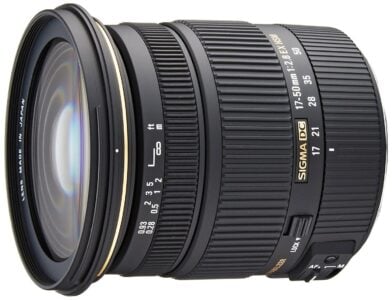
- Weight: 1.24 lb/565 g
- Dimensions: 3.3” x 3.6”
- Filter Size: 77mm
- Image Stabilization: Yes
- Price: $278
For those who might find the Canon EF-S 17-55mm f/2.8 too expensive, the Sigma 17-50 f/2.8 EX DC OS HSM is an excellent alternative. For a couple of hundred dollars less, you have a lens that offers similar optical performance, image stabilization, and a fast aperture. The Sigma is one of the best bang-for-your-buck lenses on this list and is our choice for best budget travel lens for Canon’s EF-S mount.
The Sigma 17-50 f/2.8 EX DC OS HSM performs in a very similar way to the Canon EF-S 17-55mm f/2.8 – sharpness is overall very good though the edges are soft, more so in the Sigma than the Canon. Chromatic aberrations are present to some degree and vignetting is a little stronger when the lens is shot wide-open. Each lens does produce slightly different distortions and CAs but these differences are minor enough to feel more like distinct and amiable personality traits.
Image stabilization (referred to as optical stabilization in Sigma lenses) is built into the Sigma 17-50 f/2.8 and works well. Like the Canon EF-S 17-55mm f/2.8, the Sigma 17-50 f/2.8 EX DC OS HSM excels in low-light situations because of its optical stabilization and fast aperture.
The Sigma 17-50 f/2.8 EX DC OS HSM is a bit lighter than the Canon EF-S and the barrel is shorter as well. The plastic construction leaves a bit to be desired but the lens still feels solid enough. Many users report that the focus ring is a bit annoying to use as well.
- Great bang for your buck.
- Excellent center sharpness.
- Fast aperture and IS.
- Edges are soft at lower apertures.
- Plastic construction.
- Tedious focus ring.
Best EF-S Professional Canon Travel Lens
Sigma Art 18-35mm f/1.8
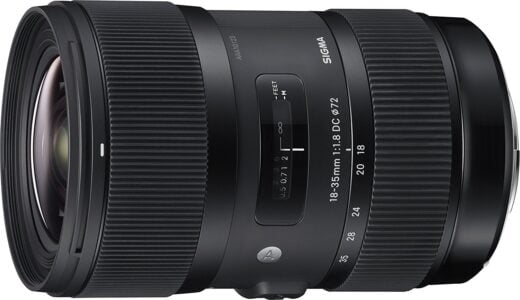
- Weight: 1.78 lb/811 g
- Dimensions: 3.07” x 4.76”
- Filter Size: 72mm
- Image Stabilization: No
- Price: $799
If there was a lens that would convince someone to invest in the EF-S mount, it would be the Sigma Art 18-35mm f/1.8. Simply put, this lens is one of the most gorgeous, most effective, and most admired lenses in all of the photographic world. It is, without question, the best premium EF-S Canon travel lens that a professional could buy
The Sigma Art 18-35mm f/1.8 has it all – amazing optical quality, excellent construction, a fast aperture, and blazing autofocus. Even at its widest aperture (f/1.8), the Sigma Art 18-35mm f/1.8 is amazingly sharp from corner to corner, which is very impressive. Chromatic aberrations, vignetting, and distortion are still present but in microscopic amounts.
The Sigma Art 18-35mm f/1.8 is made from various alloys and feels very robust. Topping out at over 800 grams, this lens is definitely on the heavier side but, for many photographers, this adds a nice balance to the lens and feels good in their hands.
The focal range of the Sigma Art 18-35mm f/1.8 can feel a little limited for some photographers. Luckily, this range still contains some very useful focal lengths and users will still be adept at taking photos of everything from landscapes to portraits. Given the unprecedented performance of this lens as well, we think that it’s a worthy tradeoff.
- Extremely sharp at all apertures.
- Very fast.
- Very few optical blemishes (CA, distortion, vignetting, etc).
- Big.
- Expensive.
- Focal range may be too limited for some.
Best EF-S Prime Canon Travel Lens
Canon 50mm f/1.8 STM

- Weight: 5.64 oz/160 g
- Dimensions: 2.72” x 1.54”
- Filter Size: 49mm
- Image Stabilization: No
- Price: 109.99
It’s back! Regardless of which Canon mount that you use, the Canon 50mm f/1.8 STM is still one of the best deals that you can find. Few lenses can compete with this one as no other offers the sharpness, size, and versatility this one does for such a low price. It is, above all else, the best budget Canon lens for travel of any sort, period.
Even though this lens was developed for the full frame Canon EF system, it can still be mounted on an EF-S body. By doing so, the lens’ focal length will effectively be extended – to 75mm – for certain technical reasons. Overall image quality isn’t affected in the least though and some might even find this change more appealing as the increased telephoto effect is great for portraits.
For a complete review of this lens, refer to our former expository. Aside from the focal length, little will be different about the Canon 50mm f/1.8 STM when using it with an Ef-S camera.
- Price that can’t be beat.
- Ultra-portable.
- Excellent optics.
- Autofocus can be sluggish.
- Has to be stopped down for best optical quality.
- Some distortion.
Best EF-S Canon Travel Lens for Landscape Photographers
Canon 10-18mm f/4.5-5.6 IS STM
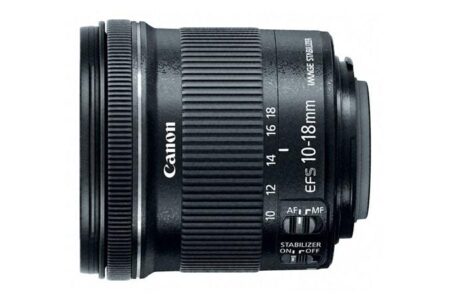
- Weight: 8.47 oz/240 g
- Dimensions: 2.94” x 2.83”
- Filter Size: 67mm
- Image Stabilization: Yes
- Price: $299
Don’t let this lens’ appearance fool you – this is one of the best Canon travel lenses for landscapes photographers out there and a must-have in their bags. Offering stellar sharpness in a tiny package and at a great price, the Canon 10-18mm f/4.5-5.6 IS STM will serve you very well.
Most look at the Canon 10-18mm f/4.5-5.6 IS STM’s price tag and plastic body and immediately dismiss it as poor craftsmanship. I mean, how could something that looks so basic be worth buying?
Little do they know that the Canon 10-18mm f/4.5-5.6 IS STM is actually an extremely sharp lens at nearly every aperture setting. Seriously! Overall resolution with this lens is very impressive. Vignetting and distortion, which are common in wide-angle zooms, are still present but actually very well controlled. Chromatic aberrations are noticeable at times but these can be fixed in post processing.
Autofocus in the Canon 10-18mm f/4.5-5.6 IS STM is speedy and the included image stabilization is very handy in low-light situations. The extra 4 stops of shake compensation that you get more than makes up for the relatively slow aperture.
At less than 10 ozs as well, the Canon 10-18mm f/4.5-5.6 IS STM is very portable and should take up next to no room in your bag. The Canon 10-18mm f/4.5-5.6 IS STM’s build quality is, justifiably, subject to some criticism for being rudimentary but, given the amazing price of this lens, most will forgive this fault I’m sure.
- Small.
- Impressively sharp.
- Very good price.
- Some vignetting and distortion.
- Basic plastic construction.
- Chromatic aberrations present around the edges.
Best EF-S Canon Travel Lens Portrait Photographers
Canon 50mm f1/.4 USM

- Weight: 10.23 oz/290 g
- Dimensions: 2.91” x 1.99”
- Filter Size: 58mm
- Image Stabilization: No
- Price: $399
For those who want a little extra speed to throw out the backgrounds behind their subjects, think about upgrading to the Canon 50mm f/1.4 USM over the f/1.8. The brighter aperture combined with good image quality is sure to create some amazing shots. We at Broke Backpacker definitely recommend this lens to any portrait photographer looking for the best travel lens for Canon.
Like the 50mm f/1.8 that we talked about just prior, the Canon 50mm f1/.4 USM was designed to be used with Canon’s full-frame EF mount. When used with a cropped EF-S mount, the focal length of this lens becomes longer. This gives the benefit of isolated your subjects even more and creates some lovely bokeh.
Optically, the Canon 50mm f1/.4 USM performs well though you’ll have to stop it down to around f/4.0 or f/5.6 to achieve maximum sharpness. When used wide-open,the edges are noticeably soft while the center is somewhat less sharp. Portrait photographers may not notice this softness around the edges or even care about it as these areas are usually blurred from the bokeh anyways.
Most of the time, the Canon 50mm f1/.4 USM’s autofocus performs as it should: quickly and accurately. Many users report that the autofocus can lag at times though. The Canon 50mm f1/.4 USM does tend to behave differently depending on the camera body that it’s mounted on and autofocus may be affected as such.
Build-wise, the Canon 50mm f1/.4 USM is built from high-grade plastics that many complain feel flimsy at times. Regardless of its integrity, which is good enough, the lens is very light and compact. Packing this one around is very easy.
- Very fast aperture.
- Good price.
- Center is sharp and bokeh is dreamy.
- Needs to be stopped down for optimal sharpness.
- Focusing struggles at times.
- Plastic construction.
Best EF-S Canon Travel Lens for Astrophotographers
Samyang 16mm f/2.0 ED AS USM CS

- Weight: 1.28 lb/583 g
- Dimensions: 3.39” x 3.52”
- Filter Size: 77mm
- Image Stabilization: No
Rokinon/Samyang deliver yet again the best travel Canon lens for astrophotographers. Like full frame Canon users, those who use the EF-S mount will find that Samyang lenses will give them the best low-light performance and for the best price. In summary, the best astrophotography lens for the Canon EF-S mount is the Samyang 16mm f/2.0 ED AS USM CS.
Like most Rokinon/Samyang lenses, image quality is excellent. Center sharpness is great from the get-go at f/2.0, while the edges are only moderately so. Stopping down the lens a bit allows the edges to catch-up sharpness-wise. Chromatic aberration, vignetting, and distortion are all well-controlled.
Even though the Samyang 16mm f/2.0 is built mostly from plastics sans the metal mount the whole lens feels very sturdy. The zoom ring is perfectly damped and feels great to use. Regrettably, there are no hyperfocal markings on the actual lens, which means you’ll have to use a separate app or make the calculations yourself.
Investing in a Rokinon/Samyang lens means that you’ll have to relinquish autofocusing. While this could be a problem with certain types of shooting, autofocus isn’t very useful with astrophotography anyways. Shooting landscapes as well shouldn’t be hampered by manual focusing either. Doing both, you’ll hardly miss autofocusing.
- Great center sharpness.
- Good value.
- Fast aperture.
- Needs to be stopped down for edges to catch up.
- Manual focus.
- Lack of hyperfocal scale.
Best EF-S Canon Travel Lens for Telephoto Lovers
Canon EF-S 55-250mm f/4-5.6 IS STM

- Weight: 13.23 lb/ 375 g
- Dimensions: 2.76” x 4.38”
- Filter Size: 58mm
- Image Stabilization: Yes
For photographers who use telephoto lenses a lot to shoot wildlife or sports, there’s a lot to love about the Canon EF-S 55-250mm f/4-5.6 IS STM. This a surprisingly sharp lens that performs very well thanks to an effective autofocusing system in addition to image stabilization. Given the amazing price of the lens these days as well, the Canon EF-S 55-250mm f/4-5.6 IS STM should be in almost every Canon EF-S photographer’s bag.
We mentioned just before that the Canon EF-S 55-250mm f/4-5.6 IS STM is a surprisingly sharp lens – it is, in its own right, a very sharp lens actually. Center sharpness is excellent throughout the lens’ focal and aperture range. The edges, though slightly soft, are nice and sharp once the lens is stopped down. Overall sharpness does drop-off beyond the 200mm focal point though.
The Canon EF-S 55-250mm f/4-5.6 IS STM has a fairly slow aperture, one that you’ll probably be stopping down anyways for sharpness. Thankfully, the lens’ internal stabilization is very effective and compensates for 4 stops of shakiness. Combine this with a quick and accurate autofocus system and capturing moving objects should be less of a problem.
Construction wise, the Canon EF-S 55-250mm f/4-5.6 IS STM is just ok. The all-plastic body doesn’t necessarily scream “take me into the wilderness” but it’s still reasonably sturdy. Due to its plastic construction, the Canon EF-S 55-250mm f/4-5.6 IS STM is very light especially so for a telephoto lens. Note that there is no lens hood included with this lens.
- Great sharpness.
- Very lightweight.
- Effective autofocus and IS.
- Plastic construction.
- Aperture’s a little slow.
- No lens hood included.

Now, you could spend a fat chunk of $$$ on the WRONG present for someone. Wrong size hiking boots, wrong fit backpack, wrong shape sleeping bag… As any adventurer will tell you, gear is a personal choice.
So give the adventurer in your life the gift of convenience: buy them an REI Co-op gift card! REI is The Broke Backpacker’s retailer of choice for ALL things outdoors, and an REI gift card is the perfect present you can buy from them. And then you won’t have to keep the receipt. 😉
Buy on REI!Things to Consider When Buying the Best Travel Lenses for Canon
Lenses are just as if not more important as your travel camera! They are the ones that create the image, that bend the light to then be read by the camera sensor. Sharpness, contrast, color, composition; all of these aspects are influenced greatly by the quality of your lens.
When looking for the best travel lens for your Canon camera, there are many qualities to take into consideration. Size, aperture, IS, and more are all vital components to the making of a great travel lens.
Below is a list of features to consider when looking for the best travel lens for Canon. Note that I’m going to glossing over a lot of photographic concepts here. I’ll try and keep things clear; otherwise, feel free to post any question regarding photography in the comment section below.
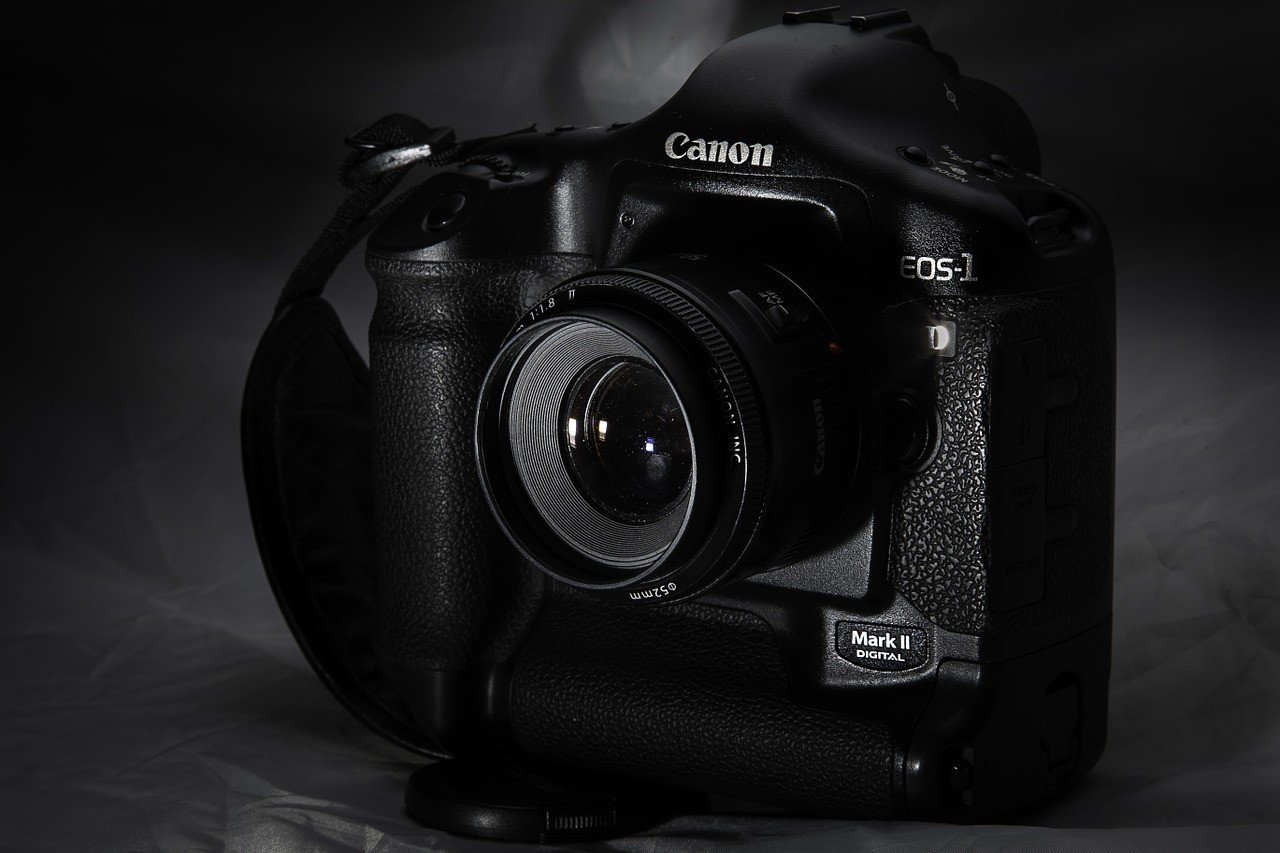
Size/Weight
Lenses come in all shapes and sizes from pint-sized pancakes to behemoth, tree-trunk-like tools. How big and heavy a lens thus influences how you carry and use it.
Larger lenses obviously take up more space and so leave less for other lenses or accessories. As you start packing more as well, the weight of your bag gets heavier and heavier. I personally have carried both heavy backpacks and shoulder bags and can say it’s fun for about 5 minutes.
If you have limited space in your camera bag or like lenses that happen to be larger, you’ll have to pick and choose your equipment wisely. Take note of how much a lens weighs and its dimensions and then think about how much you’re willing to carry.
If you’re going to be bringing a lot of equipment with you, be sure to invest in a good travel camera bag as well! You’ll need something spacious and secure to protect your equipment to the max. Read our article on the best travel camera bags for some suggestions!
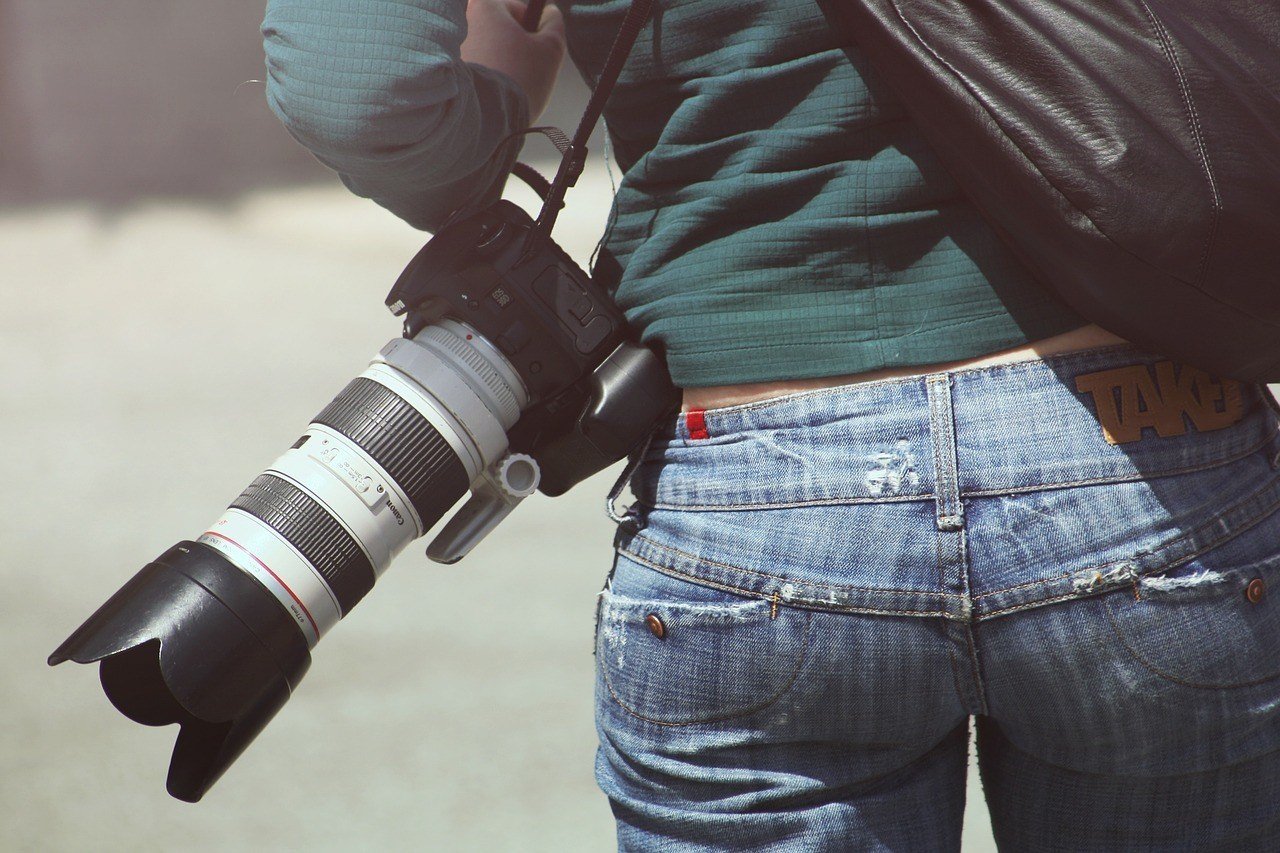
Aperture
Along with shutter speed and ISO, aperture is a key part of the exposure triangle, which must be considered if you want to take great photos. Though shutter speed and ISO fall within the realm of the camera, the aperture is directly controlled by the lens. How an aperture behaves directly influences what kind of photos you can take and can also lead to some pretty creative compositions.
A fast aperture – one that is less than or around f/2.8 – is almost always preferable. Though not always the case, a faster aperture is usually indicative of optical quality, It is also useful during certain photographic situations. Without going too deep into the mechanics, a faster aperture means that your camera can take in more light and, thus, be more suited for dimmer situations. Moral of the story: a smaller aperture number (meaning faster) is most often a good thing.
A quick aperture is not always necessary though. Lots of lenses with slower apertures can offer exceptional image quality e.g. the Canon EF 16-35mm f/4.0L IS USM. Besides, most lenses don’t even reach optimal sharpness until they’re stopped down to f/5.6 or f/8. Unless you really need a fast aperture for low-light performance or for creating bokeh, you may not need to spend the extra money.

Focal Length/Type
A lens’ focal length dictates its field of view, which, in turn, determines how large the compositional frame is. The wider the focal length, the wider the field and the more you can capture in a photo. In addition, depth is influenced as well – foregrounds and backgrounds appear closer when shot with a longer lens and further apart with a wider lens. Focal length is measured in millimeters e.g. 12mm, 50mm, 70-200mm.
Certain lenses with certain focal lengths are better for capturing certain scenes. Longer lenses, renowned for their shallow depth of field and isolating qualities, are great for portraits. Wider lenses, with their expansive fields of view, are great for interior shots when space is tight or for capturing big vistas.
Whether or not a lens covers a single focal length or many is something to consider as well. Prime lenses only cover one focal length but are usually sharper and less prone to optical abnormalities. Zoom lenses cover multiple focal lengths but can suffer from image softness, chromatic aberrations, and distortion. Higher quality zoom lenses suffer less from these issues but you’ll have to pay a pretty penny for them.
What type of photographer you are will determine what kind of focal length you find most useful. You’ll often find that certain lengths are more attractive to your style of shooting or that you favor a particular lens over others. Remember too that any lens can be useful if they’re used by a skilled set of hands. A good photographer can take beautiful landscape photos with a telephoto lens or create an alluring portrait using a super-wide angle.

Focusing
Not every autofocusing system is created equal – some are lightning fast, utilizing state-of-the-art technology, while others are sluggish doofuses that can’t make heads or tails of a subject. How well an autofocus system behaves in a lens may or may not frustrate you depending on your photographic style.
Generally speaking, most lenses autofocus pretty well. Only in rare situations does a lens really suffer from poor autofocus and most of the time these are pretty much shunned.
Certain photographers, like sports or wildlife photographers, may need better than average autofocusing to keep up with their subjects. If you need an autofocus system for your style of shooting, be sure to see if your potential new lens is up to parr. Also know that camera sensors play an important part in autofocusing as well so, if you keep finding yourself unimpressed, it could be more than the lens.
Though autofocusing is currently the dominant trend in modern photographic equipment, lens that use manual focusing are still common. Of particular note, Rokinon/Samyang lenses are only manual focus, a decision made by the company to cut costs.
Manual lenses can still be useful in certain situations. Landscape and astrophotographers feel their limitations less, due to their subject matter, and may even enjoy their vintage-like feel, much like a musician might enjoy an old record.

Filter Thread
Each lens has a certain filter threading found at the front of the barrel, which is used to attach various (you guessed it) filters. These filters e.g. polarizers, NDs, UVs are used for both creative effects and sometimes additional protection.
There really isn’t such a thing as a proper filter threading. Most filter sizes have become standardized and there is almost always a full set of filters for each one. No matter your lens, there’s a filter that will fit it.
Filter sizes do play in part in costs though. If you have multiple lenses with multiple filter threadings, you may end up spending more money for more filters, many of which maybe perform in the same way. Buying the same filter twice just to accommodate different lenses is super annoying.
To avoid this issue, try investing in a single set of filters, preferably with a larger threading, and than use step-down rings. These handy accessories are adapters for your filters and will allow you to install larger filters on lenses with smaller threadings. Or think about investing in a slot-in filter system, which uses a screw-in adapter to hold a plate-like filter. Polarizer filters are not effective with slot-in filter systems.

Image Stabilization
Image stabilization or optical stabilization technology has become extremely commonplace in modern-day lenses. This tech is found in all sorts of lenses, from cheap pieces of shit to luxurious professional-grade glass. It is, at the end of the day, a very useful feature to have in your lenses as it can allow for some very crisp images.
Image stabilization (IS) works by compensating for shake caused by hand holding a camera. This shakiness is, unless you’re using a tripod, often unavoidable. Shakiness appears as blurring in images and so they are usually unusable (though some photographers have found a creative way to use shake). With image stabilization, handheld shooting becomes much easier as you have to worry less about steadying your hand.
Whether or not you need image stabilization is something to consider in choosing the best Canon travel lenses. If you’re a landscape photographer who constantly has their camera mounted on a tripod, image stabilization is pretty redundant. On the other hand, if you shoot subjects that require you to move often or you just like to have your camera ready in your hands, then IS would be useful.
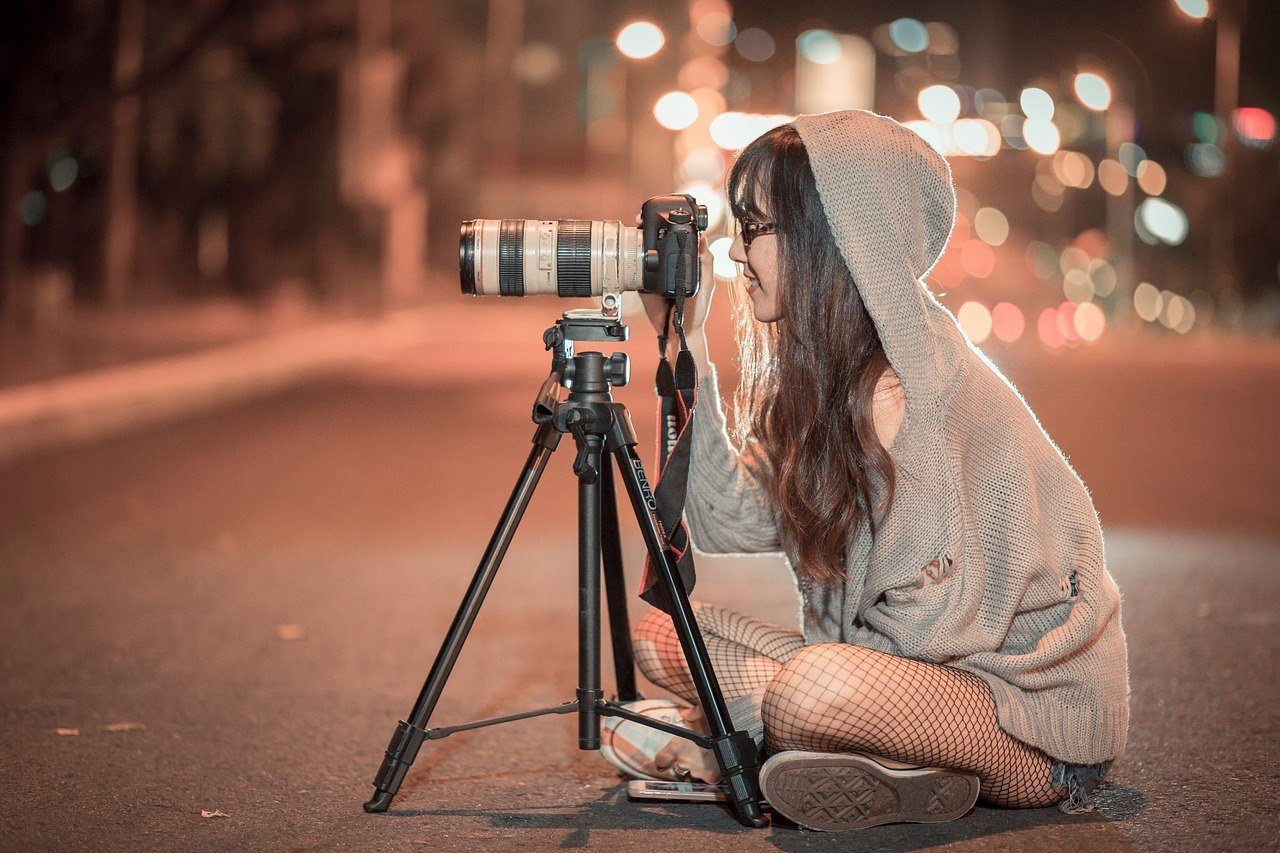
Sensor Size
You’ll see two types of Canon lenses out there: EF and EF-S. This is because certain lenses are designed for certain sensor sizes. EF lenses are meant to be mounted on full frame Canon cameras while EF-S lenses are meant for APS-C or crop sensor Canon cameras.
Lenses are designed to be paired with their corresponding sensor sizes for reasons that are technically challenging and too time-consuming to explain right now. Just understand that a lens will most often function best with the sensor that it was designed for. Some lenses do get along quite well with different sensor sizes and you’ll have to study which ones these are. Keep this in mind when purchasing a travel camera lens.
You can mount full frame lenses on APS-C cameras (and not vice versa), again, for certain technical reasons. Optically, the lens should perform somewhat similar to its native sensor type – vignetting may increase but sharpness is often not affected. Of very important note, the focal range will be lengthened when mounting a full frame lens onto a crop sensor body – a 24mm EF lens mounted onto EF-S camera will behave more like a 35mm lens.
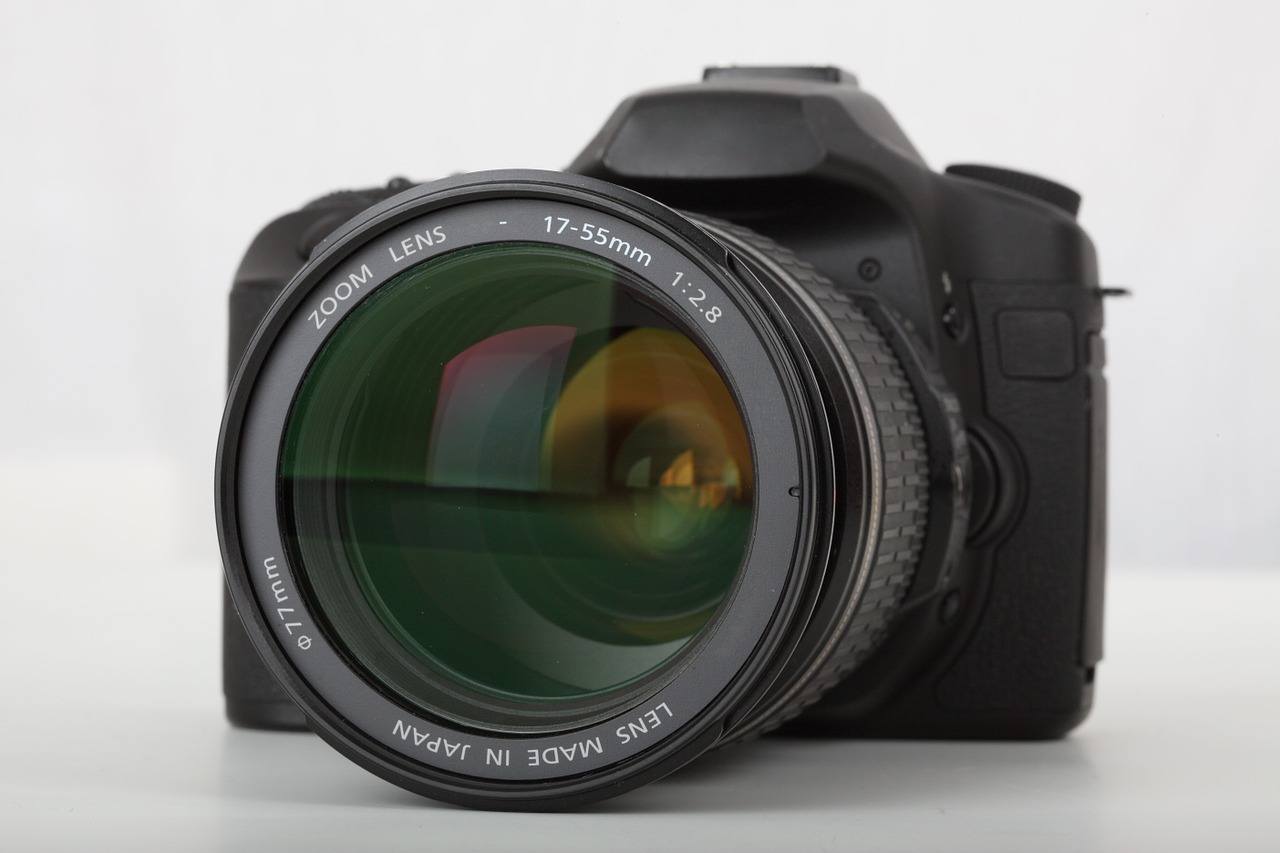
| Name | Weight (lbs & kg) | Dimensions (CM) | Filter Size (MM) | Image Stabilization (Y/N) |
|---|---|---|---|---|
| Canon EF 24-105mm f/4.0 L IS USM | 1.47 lbs / 0.67 kg | 8.36 x 10.69 | 77 | Y |
| Tamron 28-75 f/2.8 XR Di LD | 1.12 lbs / 0.21 kg | 7.29 x 9.19 | 67 | N |
| Canon 24-70mm f/2.8L II USM | 1.77 lbs / 0.81 kg | 8.84 x 11.30 | 82 | N |
| Canon 50mm f/1.8 STM | 0.35 lbs / 0.16 kg | 6.91 x 3.91 | 49 | N |
| Canon EF 16-35mm f/4.0L IS USM | 1.35 lbs / 0.62 kg | 8.26 x 11.28 | 77 | Y |
| Canon 85mm f/1.8 USM | 0.94 lbs / 0.43 kg | 7.49 x 7.14 | 58 | N |
| Rokinon 20mm f/1.8 AS ED UMC | 1.09 lbs / 0.50 kg | 8.31 x 8.84 | 77 | N |
| Canon 70-200 f/4.0L USM | 1.55 lbs / 0.71 kg | 7.6 x 17.19 | 67 | N |
| Canon EF-S 17-55mm f/2.8 IS USM | 1.42 lbs / 0.65 kg | 8.36 x 11.04 | 77 | Y |
| Sigma 17-50 f/2.8 EX DC OS HSM | 1.24 lbs / 0.57 kg | 8.38 x 9.14 | 77 | Y |
| Sigma Art 18-35mm f/1.8 | 1.78 lbs / 0.81 kg | 7.79 x 12.09 | 72 | N |
| Canon 50mm f/1.8 STM | 0.35 lbs / 0.16 kg | 6.91 x 3.91 | 49 | N |
| Canon 10-18mm f/4.5-5.6 IS STM | 0.53 lbs / 0.24 kg | 7.47 x 7.19 | 67 | Y |
| Canon 50mm f1/.4 USM | 0.64 lbs / 0.29 kg | 7.39 x 5.05 | 58 | N |
| Samyang 16mm f/2.0 ED AS USM CS | 1.28 lbs / 0.58 kg | 8.61 x 8.94 | 77 | N |
| Canon EF-S 55-250mm f/4-5.6 IS STM | 0.83 lbs / 0.37 kg | 7.01 x 11.13 | 58 | Y |
FAQ about the Best Canon Travel Lenses
Still have some questions? No problem! We’ve listed and answered the most commonly asked questions below. Here’s what people usually want to know:

Our GREATEST Travel Secrets…
Pop your email here & get the original Broke Backpacker Bible for FREE.
Final Thoughts
So there you have them – the best travel lenses for Canon! We’ve covered 16 lenses – 8 for each of Canon’s mounts – and every one of them is unique. Each one has its own strengths and weaknesses and each quality needs to be taken into consideration when looking for the best Canon lenses for travel photography.
Consider what kind of photographer you are and what kind of lens(es) you need. Do you like to photograph wildlife or faraway subject? Then buy a telephoto lens like the Canon 70-200mm f/4.0 L USM. Maybe you like to shoot landscapes and want to try your hand at astrophotography? Invest in a fast, wide-angle prime like the Rokinon 20mm f/1.8 then!
Once you’ve realized what kind of travel photography you want practice, it’s just a matter of choosing the best Canon travel lens for yourself. Know that each one will be different and that each will dramatically affect the quality of your pictures. Lenses are, after all, the apparatus that creates the image in the first place.
So think carefully about which Canon travel lens is best for you. As one photographer once told me: “you don’t invest in an expensive camera; you invest in great glass.” Upon reaching a conclusion, just buy it! You’ll feel good knowing that you did your homework and bought the perfect lens for yourself.

Buy Us a Coffee!
A couple of you lovely readers suggested we set up a tip jar for direct support as an alternative to booking through our links. So we created one!
You can now buy The Broke Backpacker a coffee. If you like and use our content to plan your trips, it’s a much appreciated way to show appreciation 🙂




